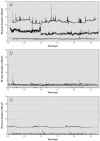Radio frequency nonionizing radiation in a community exposed to radio and television broadcasting
- PMID: 16451862
- PMCID: PMC1367839
- DOI: 10.1289/ehp.8237
Radio frequency nonionizing radiation in a community exposed to radio and television broadcasting
Abstract
Exposure to radio frequency (RF) nonionizing radiation from telecommunications is pervasive in modern society. Elevated disease risks have been observed in some populations exposed to radio and television transmissions, although findings are inconsistent. This study quantified RF exposures among 280 residents living near the broadcasting transmitters for Denver, Colorado. RF power densities outside and inside each residence were obtained, and a global positioning system (GPS) identified geographic coordinates and elevations. A view-shed model within a geographic information system (GIS) characterized the average distance and percentage of transmitters visible from each residence. Data were collected at the beginning and end of a 2.5-day period, and some measurements were repeated 8-29 months later. RF levels logged at 1-min intervals for 2.5 days varied considerably among some homes and were quite similar among others. The greatest differences appeared among homes within 1 km of the transmitters. Overall, there were no differences in mean residential RF levels compared over 2.5 days. However, after a 1- to 2-year follow-up, only 25% of exterior and 38% of interior RF measurements were unchanged. Increasing proximity, elevation, and line-of-sight visibility were each associated with elevated RF exposures. At average distances from > 1-3 km, exterior RF measurements were 13-30 times greater among homes that had > 50% of the transmitters visible compared with homes with < or = 50% visibility at those distances. This study demonstrated that both spatial and temporal factors contribute to residential RF exposure and that GPS/GIS technologies can improve RF exposure assessment and reduce exposure misclassification.
Figures


References
-
- Allen SG. Radiofrequency field measurements and hazard assessment. J Radiol Prot. 1991;11:49–62.
-
- Anglesio L, Benedetto A, Bonino A, Colla D, Martire F, Fusette S, et al. Population exposure to electromagnetic fields generated by radio base stations: evaluation of urban background by using provisional model and instrumental measurements. Radiat Prot Dosimetry. 2001;97:355–358. - PubMed
-
- Cleveland R. 1998. Summary of FCC Survey at Lookout Mountain Antenna Site. Washington, DC:U.S. Federal Communications Commission, Office of Engineering and Technology.
-
- Colorado Department of Public Health and Environment 2004. Update: Tumor Incidence in Residents Adjacent to the Lookout Mountain Antenna Farm, 1979–2002, Golden, Colorado. Denver, CO:Colorado Department of Public Health and Environment. Available: http://www.cdphe.state.co.us/dc/envtox/envtoxhom.asp [accessed 1 July 2004].
Publication types
MeSH terms
Grants and funding
LinkOut - more resources
Full Text Sources

